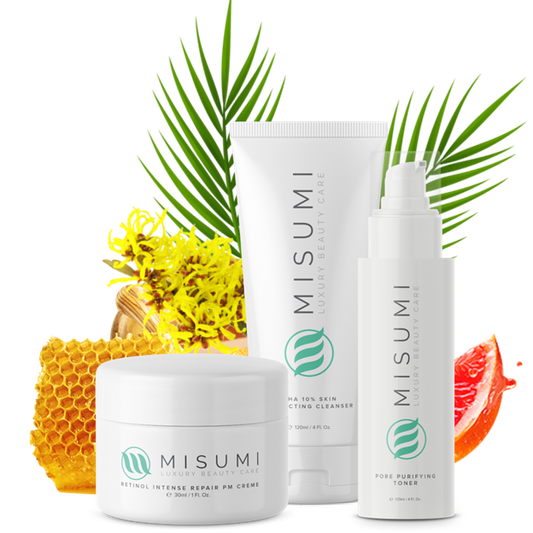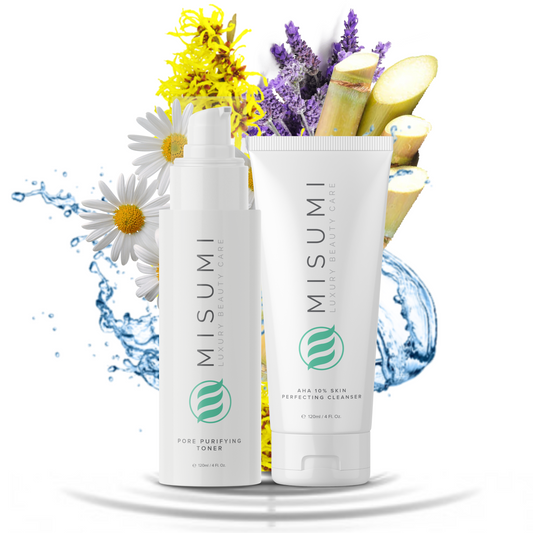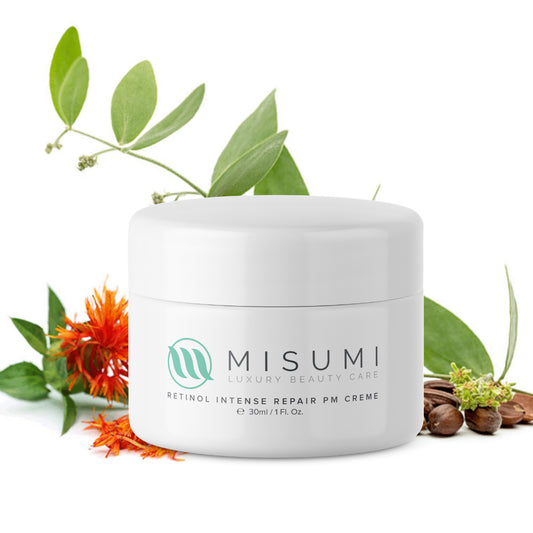Having clear, healthy skin is a priority for many people. Unfortunately, blackheads and whiteheads on the face can be common issues that are difficult to address. But don't worry. With knowledge of what causes these blemishes and how to properly treat them, you will soon have your desired complexion without any unwanted marks. In this article, we discuss blackheads and whiteheads on the face - their cause, prevention methods, as well as safe treatments to get rid of them once they appear. Keep reading if you want to learn more about tackling those pesky pimples.
Blackheads and Whiteheads
Blackheads and whiteheads are two common types of acne that can appear on the skin. Blackheads, also known as open comedones, are small bumps with a dark center caused by clogged pores. Whiteheads, or closed comedones, are similar to blackheads but have a white center due to trapped sebum and bacteria beneath the surface of the skin.

Blackheads: What are Blackheads?
Blackheads are small, dark bumps that appear on the skin. They're caused by clogged hair follicles and are a type of acne. Blackheads form when excess oil, dirt, and dead skin cells build up in the pores of your skin. The black color is not due to dirt but rather from oxidation which causes the oil to turn black when exposed to air.
Blackheads can occur anywhere on your body where you have hair follicles, such as your face, neck, chest, back, or shoulders. They often appear in areas with more sebaceous glands, like the nose or chin, because these areas produce more oil than other parts of the body.
The best way to prevent blackheads is by keeping your skin clean and clear of excess oils and debris that can cause them to form. This means washing your face twice daily with a gentle cleanser that won't strip away natural oils while also exfoliating regularly with an exfoliant designed for use on acne-prone skin types. Additionally, using products specifically formulated for oily or combination skin will help keep excess oils at bay so they don't accumulate in pores and lead to breakouts, including blackheads. Finally, it is important to avoid picking at existing blemishes as this can spread bacteria further into pores leading to infection and inflammation, which could worsen existing blemishes or even create new ones.
Blackheads are a common skin issue, but understanding the causes and how to treat them is key to getting rid of them. Next, let's take a look at what causes blackheads on the face.
What Causes Blackheads?
Blackheads are a type of acne that can affect people of all ages. They appear as small, dark spots on the skin and are caused by clogged pores. The main culprit behind blackheads is excess oil production in the skin, which can be triggered by hormonal changes or improper skin care.
Hormonal Changes:
Hormones play an important role in regulating our body's natural processes, including oil production. During puberty and other times when hormones fluctuate, such as during pregnancy or menopause, increased levels of certain hormones can cause an increase in sebum (oil) production, which leads to blackhead formation.
Improper Skin Care:
Improper cleansing habits can also lead to blackhead formation. When dirt and bacteria accumulate on the surface of your skin due to not washing it properly or often enough, this creates a breeding ground for bacteria which then get trapped inside your pores, leading to blackheads forming over time. Additionally, using harsh cleansers that strip away too much oil from your face may trigger your body to produce more sebum than usual, resulting in blocked pores and, eventually, blackheads appearing on the surface of your skin.
Using Products with Comedogenic Ingredients:
Using skincare products containing comedogenic ingredients like mineral oils or lanolin can also contribute to clogged pores and the eventual development of blackheads if used excessively over time without proper cleansing afterward. These ingredients have been known to block up pores when used regularly, so it's best avoided if you're prone to developing these types of blemishes easily.
Overall, there are many factors that could lead to the formation of unsightly blackheads. Understanding what causes them is key to preventing their occurrence altogether. By following a good skincare routine, avoiding harsh cleansers, keeping track of any hormonal fluctuations, and being mindful about product usage, one should be able to keep those pesky little bumps at bay.
Blackheads are caused by a buildup of dirt, oil, and bacteria in the pores. To safely remove them, it's important to understand how they form and what treatments can be used to reduce their appearance. Next, we'll discuss how to get rid of blackheads safely.
Key Takeaway: Key takeaway: To prevent blackheads, practice a good skincare routine (cleanse regularly and avoid harsh cleansers), track any hormonal fluctuations, and be mindful of product usage.
How Do I Get Rid of Blackheads Safely?
Blackheads are a common skin concern that can be frustrating to deal with. They occur when pores become clogged with excess oil, dirt, and dead skin cells. Fortunately, there are several treatments available for safely removing blackheads from the face.
One of the most popular methods for treating blackheads is manual removal. This involves using a tool such as tweezers or an extractor to gently squeeze out the contents of each pore. It's important to be careful when performing this procedure as it can cause irritation and damage if done incorrectly.
Over-the-counter (OTC) treatments are also effective at reducing blackhead buildup on the skin's surface. These products typically contain ingredients like salicylic acid or benzoyl peroxide, which help break down oils and unclog pores while preventing new ones from forming. OTC treatments should always be used according to their instructions in order to avoid any adverse reactions or further irritation of the skin.
Prescription medications may also be prescribed by a doctor in cases where over-the-counter remedies aren't enough to treat stubborn blackheads or acne breakouts caused by them. These medications usually come in topical creams, gels, lotions, or ointments that work by killing bacteria and reducing inflammation within the pores so they don't get blocked again as easily.
Chemical peels are another option for those looking for more intensive treatment options for their blackhead problem areas. Chemical peels use various acids like glycolic acid and lactic acid, which exfoliate away dead skin cells while simultaneously helping reduce inflammation around existing blemishes. However, these types of procedures should only ever be performed under professional supervision due to potential side effects associated with chemical peels.
Microdermabrasion is yet another form of treatment used specifically on stubborn blackhead areas that have been resistant to other forms of therapy. Microdermabrasion works by physically exfoliating away dead skin cells through gentle abrasion techniques applied directly onto affected areas, thus allowing fresh new layers of healthy skin underneath it all to shine through without obstruction.

Finally, laser and light therapies have recently gained popularity among dermatologists who specialize in treating severe cases of acne caused by a chronic blockage within facial pores. During these sessions, intense beams of light target specific areas where large amounts of sebum buildup have occurred over time - destroying bacteria present inside each pore before finally sealing them shut afterward so no more blockages can occur anytime soon afterward.
When deciding what type of treatment will best suit your needs, always consult with a healthcare provider beforehand. Certain conditions require special attention, and a medical history must be taken into account before proceeding any further.
Using a gently exfoliating scrub and regular cleansing with a mild cleanser can help remove blackheads safely. For long-term prevention, it's important to maintain healthy skin habits, such as avoiding touching your face, washing your face twice daily, and using products that are tailored to your skin type. Let's take a look at how to prevent blackheads from forming in the first place.
Key Takeaway: Blackheads can be effectively treated with manual removal, OTC treatments, prescription medications, chemical peels, microdermabrasion, and laser light therapies. It's important to use caution when performing any of these procedures, as they can cause irritation or damage if done incorrectly.
How to Prevent Blackheads?
Fortunately, there are steps you can take to prevent blackheads from forming in the first place.
Wash Regularly:
Keeping your face clean is one of the best ways to prevent blackheads. Wash your face twice daily with a gentle cleanser and warm water. Avoid scrubbing too hard, as this may irritate your skin and cause more breakouts.
Use Oil-Free Products:
Choose oil-free products for both makeup and skincare whenever possible. This will help keep excess oils from clogging pores which can lead to blackhead formation. Make sure to remove all makeup before bedtime so it doesn't have time to accumulate on the surface of your skin overnight.
Try an Exfoliating Product:
Using an exfoliating product once or twice a week helps remove dead skin cells that can build up on the surface of your skin, leading to clogged pores and potential blackhead formation over time. Look for products containing alpha hydroxy acids (AHAs) or beta hydroxy acids (BHAs). These ingredients gently dissolve away any buildup without causing irritation or damage to delicate facial tissue like some physical exfoliants do when used too often or aggressively applied onto the skin's surface area during the application process itself.
Finally, consider using a clay mask once per week as part of your regular skincare routine; these masks absorb excess oils while helping draw out impurities from deep within pores, preventing them from becoming blocked by debris such as dirt particles, sweat, etc. Be sure not to leave it on longer than recommended, though. Otherwise, it could dry out your complexion unnecessarily.
By following a regular skincare routine, including cleansing and exfoliating regularly, you can help to reduce the chances of developing blackheads. Now let's take a look at whiteheads and what causes them.
Key Takeaway: To prevent blackheads, it's important to wash your face regularly with a gentle cleanser, use oil-free products, exfoliate once or twice a week and apply a clay mask once per week.
Overview of Whiteheads
Whiteheads are a type of acne that forms when the skin's pores become clogged with oil, dirt, and bacteria. They appear as small white bumps on the surface of the skin. Whiteheads are very common among teenagers and adults alike.
Whiteheads can be caused by hormonal changes in puberty or due to stress levels, diet, genetics, and certain medications. People who have oily skin tend to be more prone to developing whiteheads than those with dry or normal skin types.
Key Takeaway: Whiteheads can be caused by hormonal changes, diet, genetics, and certain medications. To get rid of them, use a cleanser to remove oils from the skin and an exfoliator to unclog pores. Treatment options include topical creams, retinoids, antibiotics, or laser therapy.
What Causes Whiteheads?
Whiteheads are a form of acne that can be caused by a variety of factors. The most common cause is an increase in sebum production, which leads to clogged pores and the formation of white bumps on the skin. Hormonal imbalances, such as those experienced during puberty or pregnancy, can also lead to whiteheads. Other potential causes include stress, poor hygiene habits, and certain medications.
Excess oil production is one of the primary culprits behind whitehead formation. When too much sebum (oil) is produced by your body's sebaceous glands, it accumulates in your pores and creates a blockage that traps bacteria beneath the surface of your skin. This results in inflammation and redness around the blocked pore, forming what we know as a whitehead.
Hormones are a key factor in the formation of whiteheads, as they control how much oil our bodies produce. Imbalances in hormones due to puberty or pregnancy can lead to an increase in sebum production and result in more frequent breakouts with both blackheads and whiteheads appearing on the face or other areas prone to acne, such as the shoulders or back. Stress has also been linked to hormonal changes, which may contribute further to this issue, so reducing stress levels should be taken into consideration if you wish to reduce your chances of developing these blemishes.
Whiteheads are caused by a combination of excess sebum production, bacteria, and dirt clogging pores. To get rid of them, the next step is to understand how to remove whiteheads from your face.
Key Takeaway: Whiteheads are a form of acne caused by excess oil production, hormonal imbalances, stress, and poor hygiene habits. To reduce the chances of developing whiteheads: • Keep skin clean • Reduce stress levels • Avoid certain medications.
How to Remove Whiteheads?
Whiteheads are a common skin condition that can be caused by several factors, including hormones, genetics, and lifestyle choices. They occur when dead skin cells and sebum (oil) become trapped in the pores of your skin. This results in small white bumps on the surface of your face or body. While they may not be as noticeable as blackheads, whiteheads can still cause embarrassment and distress for many people. Fortunately, there are ways to safely remove them from your skin without causing any damage or irritation.
One way to remove whiteheads is with a comedone extractor tool. This device has two loops at one end that allow you to gently press down on either side of the whitehead and then pull it out from its root. It's important to make sure you use clean tools each time you do this so that bacteria isn't transferred onto your skin, which could lead to infection or scarring. Additionally, never attempt to pop a whitehead yourself, as this can also lead to infection or scarring if done incorrectly.
Another option for removing whiteheads is using topical retinoid creams such as tretinoin cream 0.05%. These creams help reduce oil production in the pores while exfoliating away dead skin cells, which helps prevent new breakouts from forming over time. Retinoids should only be used after consulting with a dermatologist since they may cause redness and irritation if used too often or improperly applied.
Finally, another method for managing whiteheads is through regular exfoliation. Exfoliating removes excess dirt, oils, makeup residue, and other debris from clogging up your pores. You should aim for gentle exfoliation 2-3 times per week, depending on how sensitive your skin is. Be sure not to scrub too hard though because this could irritate already inflamed areas leading to further breakouts.
For more stubborn cases of acne where these methods aren't enough, it is best to consult with a healthcare provider who will provide personalized advice tailored specifically toward treating your individual needs.
With the right skincare routine and products, whiteheads can be effectively treated. Read on to learn about treatments for whiteheads that you can incorporate into your daily regimen.
Key Takeaway: Whiteheads can be safely removed using a comedones extractor tool, topical retinoid creams such as tretinoin cream 0.05%, and regular exfoliation. For more stubborn cases of acne, consult with a healthcare provider for personalized advice.
FAQs in Relation to Blackheads and Whiteheads on Face
How do you get rid of blackheads and whiteheads on your face?
The best way to get rid of blackheads and whiteheads on the face is to use a combination of cleansing, exfoliating, and moisturizing. First, start by using a gentle cleanser twice daily to remove dirt and oil from your skin. Then, exfoliate with an appropriate scrub or mask at least once a week to help loosen any trapped dirt in the pores. Finally, finish off with a light moisturizer that won't clog pores but will keep skin hydrated. With regular care and maintenance, you can reduce the appearance of blackheads and whiteheads on your face over time.
What kills blackheads and whiteheads?
Blackheads and whiteheads can be treated with a combination of cleansing, exfoliating, and topical treatments. Cleansing helps to remove dirt, oil, and bacteria from the skin's surface. Exfoliation removes dead skin cells that can clog pores and cause blackheads or whiteheads. Topical treatments such as benzoyl peroxide or salicylic acid help to reduce inflammation in the pores while also killing acne-causing bacteria. Regular use of these products will help keep your skin clear of blackheads and whiteheads over time.
What causes blackheads and whiteheads on the face?
Blackheads and whiteheads are caused by a buildup of oil, dirt, and bacteria in the pores. When these substances become trapped in the pore, they can cause it to become clogged. The skin then forms a plug over the top of the pore, which is known as a blackhead or whitehead. Blackheads are typically dark due to oxidation, while whiteheads appear lighter because they remain covered with skin cells. A proper skincare routine, including cleansing and exfoliating, can help prevent blackheads and whiteheads from forming on your face.
Do whiteheads and blackheads go away?
Whiteheads and blackheads are common skin conditions caused by clogged pores. While they can be frustrating, the good news is that with a proper skincare routine and products, whiteheads, and blackheads can be managed over time. Regular cleansing of the face with gentle cleansers helps to keep pores clear of dirt, oil, and bacteria which may lead to breakouts. Exfoliating regularly also helps remove dead skin cells from the surface of your skin, which can help reduce the appearance of whiteheads or blackheads. Additionally, using products specifically designed for acne-prone skin, such as salicylic acid or benzoyl peroxide, will help unclog pores and prevent future breakouts. With consistent care and attention to your skincare routine, you should see an improvement in your complexion over time.
Conclusion
In conclusion, blackheads and whiteheads on the face can be annoying problems to deal with. While they are not dangerous, they can still affect your self-confidence. It is important to understand what causes them and how to get rid of them safely in order to maintain healthy skin. There are many treatments available for both blackheads and whiteheads, from home remedies such as exfoliation or using a clay mask, to professional treatments like chemical peels or laser therapy. If you have tried all of these methods without success, it is best to consult a healthcare provider who will be able to advise you on the best course of action for your individual situation.
Are you tired of dealing with blackheads and whiteheads on your face? Misumi Skincare is here to help! Our high-quality skincare products, skincare guides, reviews, and information from medical professionals will provide the solutions you need. With our acne solutions, clear skin routine plans, and luxury beauty care products, we are sure that you can get rid of those pesky blackheads and whiteheads in no time. So don't wait any longer – start taking control of your skin today with Misumi Skincare!







